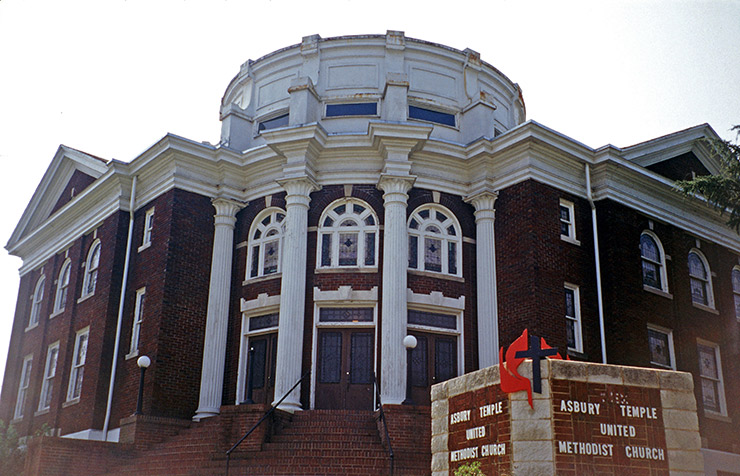
Asbury Temple United Methodist Church, Durham; (c) Soul Of America
Durham Civil Rights Movement
Durham Civil Rights Movement should be revered for its contributions as much as those from Little Rock, Montgomery, Selma, Birmingham, Jackson, Greensboro, Memphis, Atlanta, Raleigh and Nashville. The city was a persistent center of effective organizing, planning and fund-raising, but seldom grabbed national headlines.
In 1959, Rev. Dr Martin Luther King began meeting with Rev. Douglas Moore of Asbury Temple United Methodist Church and Southern Christian Leadership Conference (SCLC) leaders in Durham to plan the second major strategy of the Civil Rights Movement: Direct non-violent confrontation tactics to address public segregation, called the Direct Action Strategy. Durham was an important meeting place because Durham was home to two of the largest black-owned financial companies in the South (North Carolina Mutual Insurance and Mechanics & Farmers Bank) — both early funding sources for the Durham Civil Rights Movement.
Influenced by Dr. King’s 1958 book, Stride Towards Freedom, four North Carolina A&T students sat at a segregated Greensboro Woolworth lunch counter on 1 February 1960. As profiles in courage, these students did so without police protection, financial support or sufficient bail money. Days later, other North Carolina Sit-ins kicked off by students from North Carolina Central University in Durham, Shaw University in Raleigh, Winston-Salem State University in Winston-Salem and Johnson C. Smith University in Charlotte. Heading one of the richest black business communities nationwide, Durham’s black business leaders were particularly important for their ongoing meeting financing and bail money.
To further energize the Civil Rights Movement, Dr. King and SCLC members met again in Durham to refine their Direct Action strategy in support of college student sit-in tactics. On 16 February 1960, Dr. King proclaimed the next major SCLC strategy on the steps of White Rock Baptist Church in Durham, “Fill Up the Jails!” This strategy worked because heroic, well-mannered, childless and jobless college students could afford to spend the night in jail for organized, non-violent civil disobedience against uncivil laws.
In contrast to thugs attacking them, the students were well-mannered and well-groomed. The SCLC and NAACP sent out the call for nationwide resources to organize more sit-ins, bail students out of jail, request police protection, and invite national media coverage. After seeing these HBCU students successfully employ sit-ins in Greensboro, Winston-Salem, Durham, Raleigh and Charlotte in February, national and international money poured into the SCLC and NAACP to support Civil Rights Movement projects.
